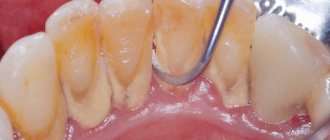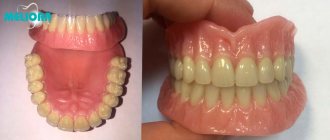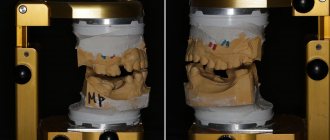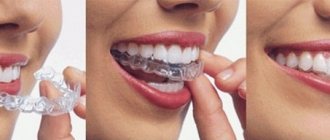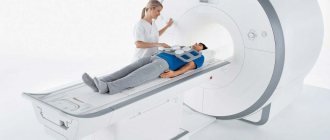Malocclusion is manifested by deformation of the position of the teeth, which grow unevenly. The pathology negatively affects the functions of the dentofacial apparatus, disrupts aesthetics, causes headaches and sleep disturbances. Implants for malocclusion are installed with minor deformation. In case of severe deviations, installation without orthodontic treatment is impossible or involves high risks. The operation will only make the situation worse. If the patient refuses orthodontic treatment, the doctor will refuse implantation.
Is it possible to place implants if there is an incorrect bite?
The possibility of installing implants is assessed based on diagnostic results and depends on the degree of bite deformation. An individual treatment plan is developed for each patient.
Preparation for installation of artificial roots includes a set of diagnostic procedures. The patient is examined by an orthopedic dentist and an orthodontist, who evaluate the condition of the bite. Violations are indicated by unevenly growing teeth, crowding, interdental spaces, and improper closure when biting. To assess the degree of pathology, plate testing and x-ray examination of the jaws are used.
Implantation with malocclusion is complicated, so the patient is offered orthodontic treatment if:
- a significant deformation has been identified in which implantation is impossible and can only cause harm;
- The deformation is insignificant, but the patient wants to achieve ideal smile aesthetics after implantation.
In case of minor violations, it is possible to install an implant without eliminating the deformation. This applies to clinical cases where a person has a slight inclination of the anterior units, a diastema or tremata, or a slight lack of space for a crown on the implant. Before the operation, the doctor discusses the nuances of the procedure with the patient and warns about possible risks.
Surgical lengthening of the coronal part of the tooth
Lengthening the tooth crown can be carried out using several techniques: surgical, orthodontic, orthopedic and therapeutic. The idea of lengthening is to increase the visible, that is, protruding above the gum, part of the tooth and/or restoration. Surgical lengthening of the crown of a tooth is performed on teeth with significant destruction of hard tissue, as well as when it is necessary to change the contour and position of the gums, for example, in people with a gummy smile. Many doctors mistakenly understand that the surgical lengthening method is only the excision of part of the gum - gingivectomy, but this technique is used only in cases of impaired passive teething, when there is no apical displacement of the gum and there is an excess of it on the tooth. Only in this case it is possible to remove part of the excess gingival margin without damaging the periodontium of the tooth. With thoughtless excision of the gingival margin and subsequent prosthetics of a given volume of the clinical crown of the tooth, a violation of the “biological width” - the zone of dentogingival attachment - occurs, which can lead to severe periodontal inflammation in this area and even tooth loss.
With the classical method of surgical lengthening, an important anatomical formation is excised - the periodontal groove, which provides protective, hygienic and immunological functions. After which it may be incompletely restored, followed by scarring and disruption of the original functions. To minimize this risk, a modernized technique of surgical tooth lengthening is used without excision of the natural gingival margin. At the moment, it is the safest and most effective way to make beautiful teeth of the desired length.
Contraindications
Implantation with malocclusion in case of serious violations is not carried out; mandatory treatment by an orthodontist is required first. The surgeon needs to install the implant correctly, which is complicated by the incorrect position of the adjacent teeth. Without eliminating the defect, it is difficult for the orthopedist to achieve the aesthetics of the crown on the installed implant. It is difficult to restore the functions of the dentofacial apparatus. The introduction of an implant and its loading with a prosthesis will only intensify deformation changes. You will have to remove the installed implants and begin orthodontic treatment.
Reasons for the development of anomalies
Factors that have a negative impact include:
- Pathological changes in the structure of tooth enamel, leading to accelerated abrasion and loss of tissue density;
- Uncontrollable grinding of teeth during sleep (bruxism);
- Incorrect distribution of chewing load, leading to displacement of units;
- Partial edentia on one or both jaws;
- Metabolic failure, causing a deficiency of useful minerals, primarily calcium and phosphorus;
- Long-term wearing of low-quality replacement structures.
Correct production of dentures requires modern equipment and a comprehensive examination carried out under conditions that ensure complete physiological rest of the jaw apparatus.
Types of pathologies and the possibility of installing implants
When the bite is imbalanced, the teeth are in the wrong position in the row or the jaws are misaligned. For each clinical case, a treatment regimen is developed:
- With incorrect position of teeth.
The degree of inclination is assessed. If dental roots or crowns do not interfere with the implantation, the operation is performed without alignment. This option is for people who do not have maximum aesthetic requirements. But to achieve a perfect smile, orthodontic treatment will be required before implantation. If the roots of adjacent teeth interfere with the installation of implants, orthodontic treatment must be prescribed. Sometimes doctors resort to surgical removal of “eights” that occupy the wrong position in the jawbone. - When the jaws are displaced.
The degree of anomaly is assessed. If the displacement is insignificant, implantation is possible - the pathology is eliminated using prostheses on implants. If there is a pronounced displacement, implants cannot be installed; it is impossible to achieve a high-quality result.
During orthodontic treatment before implantation, the patient is offered removable dentures for aesthetic restoration of the defect. Due to changes in the bite when wearing braces, dentures will have to be periodically repositioned or replaced.
Basis of construction
Determining the height of the bite is based on assessing the distance between the jaws when fully closed, which makes it possible to determine the correct development and location of the elements of the dentition. The presence of defects leads to a displacement of the main anatomical components of the jaw region - the lips recede, the facial folds increase, the chin protrudes, and the height of the lower part of the face decreases. Increasing the height of the bite restores aesthetics and facilitates further therapeutic measures.
Consequences of implantation for malocclusion
Patients who neglect orthodontic treatment are more likely to experience complications. The risk of artificial roots being rejected increases due to uneven chewing load.
If the closure of the jaws is impaired, the enamel and cutting edge wear away, and the roots do not have enough nutrition. Implantation increases the imbalance. The result of the operation will be disastrous.
If implants are installed without correcting the bite, the patient will encounter problems:
- loosening of the artificial root, its rejection;
- abrasion of enamel, destruction of living teeth;
- disruption of the jaw joint;
- pain while eating;
- mucosal injuries;
- gum loss;
- violation of diction;
- Difficulties with oral hygiene.
In severe cases, a necessary measure is to remove artificial roots, which increases the duration and cost of treatment due to additional surgical intervention.
Preparation for orthodontic treatment
Before fixing the braces, the patient visited surgeon V.P. Alaverdov for the removal of a failed wisdom tooth.
Commentary by surgeon V.P. Alaverdova: “After the initial consultation with S.V. Zukor and subsequent comprehensive consultation with specialists, the patient was referred to me, and I carried out the first stage of the approved treatment plan. 1.8 tooth was removed. When removing a wisdom tooth, atraumatic techniques were used to preserve bone and gums. Two hemostatic sponges were placed in the socket and laser biostimulation was performed. The action of laser radiation sterilizes the hole, preventing possible complications and accelerating tissue healing. The removal was successful, healing without complications.”
Hygienist E.P. Smirnova performed Air Flow teeth cleaning, ultrasonic tartar removal, and minor gum treatment. This stage is performed free of charge as part of a promotion for patients undergoing complex orthodontic treatment.
The endodontist treated tooth 1.1 (front upper tooth on the right). Treatment of tooth canals, as well as placement of fillings, is performed using a dental microscope. Root canal treatment uses high-tech instruments to penetrate the crooked, narrow canals of teeth and provide the most thorough treatment possible. Treatment of canals under a microscope provides a full guarantee of quality and a long-term prognosis, which is important when installing expensive denture structures.
What to do if the implant is already in place
After implantation, the bite cannot be corrected without complex medical procedures. Artificial roots, unlike natural ones, are absolutely motionless. When trying to correct the position, only your own teeth will change. The implant will remain in its original position.
A person is faced with a difficult choice. With a radical approach, the artificial root is removed, bite deviations are corrected, then the implant is reinstalled and loaded with a crown. The second option is to ignore aesthetic or functional defects.
Sometimes doctors place implants before correcting the bite as part of the treatment plan. After complete engraftment of the metal root, orthodontic treatment begins. With this arrangement, the teeth are attracted or repelled from a fixed support. All stages of therapy are thought out in advance. The scheme must be clearly developed by the implant surgeon together with the orthodontist.
Physiological rest
A state such as physiological rest means a state of relaxation of the muscles of the lower and upper jaws. The state of the anti-gravity reflex means that the jaws do not close together. This is a natural state that occurs when eating or talking. The normal value is 2-5 millimeters, but no more. Other indicators indicate the presence of anomalies, especially when accompanied by other violations, including symmetry.
There are two states of increased bite height:
- Overpriced. The causes of the pathology are often unprofessional previously performed treatment, in particular, the installation of prostheses. Teeth that are opposite each other always close together. During physiological rest, there is no such closure, and the deviation from the norm can be insignificant or large. In the second case, there is a risk of joint damage and tissue injury due to muscle overstrain.
- Understated. The violation usually occurs due to increased abrasion of the enamel or an unprofessionally installed prosthesis. In this case, the bite is considered low if the resting distance is greater than 3-4 millimeters, but there are no changes in the appearance or symmetry of the face. In case of complications, angular cheilitis and increased salivation are observed.






